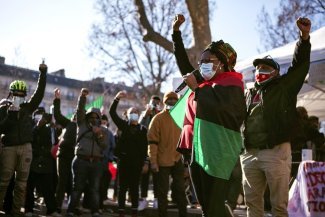By Camilo Arabe
A total of 302,600 construction workers went on strike in Brazil in the first half of 2012, according to a study released by the National Federation of Workers in Heavy Construction (Fenatracop).
Government investments in large infrastructure works, added to the preparations for the 2014 World Cup and 2016 Olympics, have meant a boom across the entire construction sector throughout the country. Thousands of building sites can now be seen across Brazil.
The construction industry as a whole represents 18.4% of Brazilian GDP, feeding US$143 billion into the national economy. However unions fear that this huge investment is not resulting in better working conditions.
Building sites are the most dangerous places to work in Brazil. Last year alone, the Supreme Labor Court (TST) dealt with more than 200,000 cases related to accidents at work occurred in the industry.
The precariousness of employment at sites across the country, and regional wage inequalities, are the main reasons for the high number of strikes, according to the research.
The Brazilian Northeast for example - historically the poorest part of the country - is where the largest numbers joined industrial actions, with around 131,000 workers striking in this region alone.
"If we analyse the regions of the country where the actions have occurred, we verify that they are exactly where wages, benefits packages and working conditions are the worst", Fenatracop states.
The survey compares salary levels, indicating that in the North, Northeast and Midwest districts they are 30% lower than in Southern Brazil.
While a worker in the Northeaster Paraiba State earns on average 776 reais (US$ 382), the monthly salary of someone doing the same job in the Rio de Janeiro State would be more than double that, at around 1,758 reais (US$867).
"The Northeast has always been overlooked. All this investment has started in the region and it was necessary to bring labourers from the South, where workers already had experience in demanding improvements", says Wilmar Gomes, president of Fenatracop.
The high number of strikes is caused precisely by workers rebelling against the differences in working conditions and the pay gap between regions. And, in most cases, they were wildcat strikes starting spontaneously by workers.
Although modest in relation to the claims, clear gains were achieved particularly in wage increases and bringing employers to the negotiating table.
In addition, a recent agreement signed between the government, unions and large building contractors to improve working conditions in the sector is considered as a positive step by the unions.
On the other hand, Fenatracop draws attention to the lack of knowledge by the judicial system to resolve conflicts and even to comprehend the reality of workers in the industry.
"The Labour Courts need a reality check. They have no idea of the precariousness and the terrible working conditions taking place in the large building projects" says Wilmar Gomes.
He adds that employers also make matters worse by "criminalising” strikes, which many times lead to the dismissal of workers taking part in the unofficial actions.
One example happened last February, when an eight-day strike at the future World Cup Pernambuco Arena claimed benefits such increase in the value of meal vouchers, health insurance for workers and days off allowances.
The case was brought to court which judged the action unlawful. Instead of demands met, the result was the dismissal of 300 strikers.
"If it is not on the interest of employers to improve working conditions and raise wages and benefits, is there any alternative for workers than going on strike to demand better working conditions?", concludes the research.
"Effectively, though difficult, the dialogue is still possible and therefore is still the best way to close a good agreement for all parties involved," answers Gomes.









